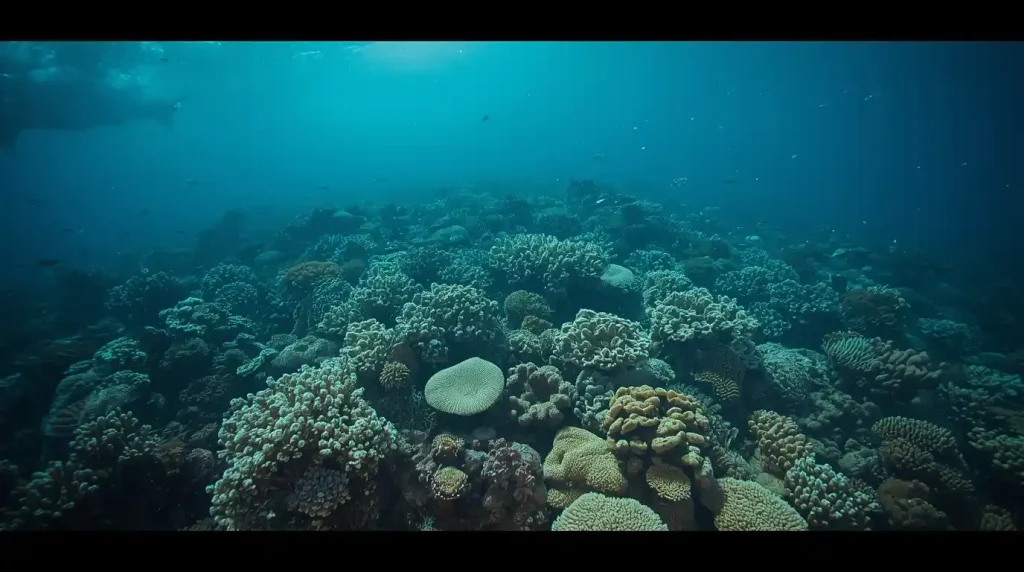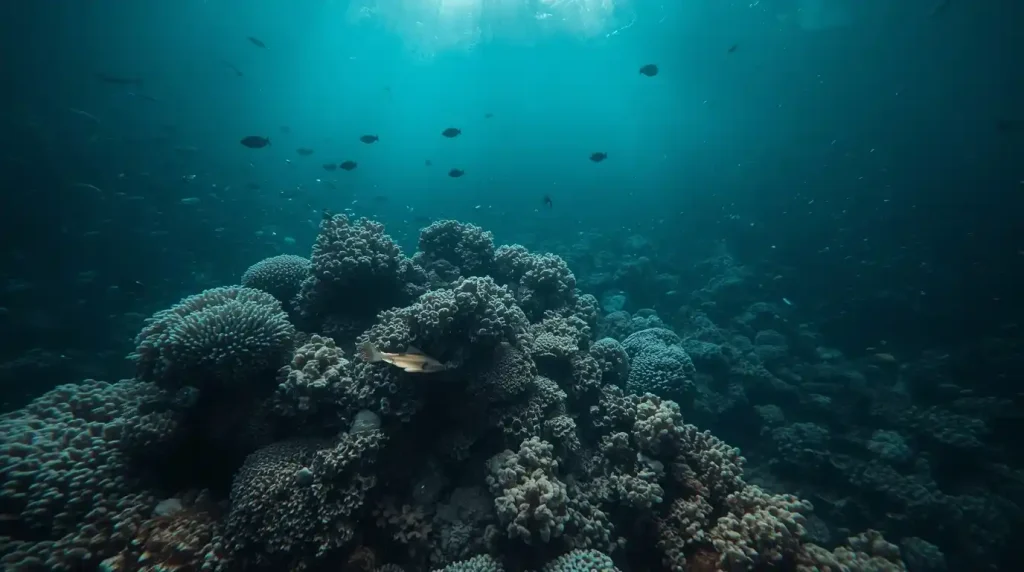The Earth is sending us an invoice, and it’s one we can no longer defer. A landmark synthesis report from the world’s leading climate scientists has delivered a stark, unequivocal verdict: the planet has entered a “new reality.” According to the research, we have now crossed the first major climate tipping point, pushing one of Earth’s critical systems into a state of irreversible collapse.
This isn’t a forecast for the future; it is a diagnosis of our present. The threshold we have passed is the large-scale functional extinction of tropical coral reefs, a death knell for marine biodiversity and a dire warning of what lies ahead. This confirmed climate tipping point signifies that the slow, gradual warming of the past is over. We are now in an era of cascading, self-perpetuating climate breakdown.
1. The Coral Catastrophe: Our First Major Tipping Point
The first confirmed climate tipping point is the functional loss of the world’s tropical coral reefs. Systems like the Great Barrier Reef have succumbed to mass bleaching events from which they cannot recover. But what does this mean in practical terms?
A climate tipping point is a threshold that, when exceeded, leads to large and often irreversible changes in a part of the climate system. For coral reefs, that threshold was a specific combination of persistently high ocean temperatures and acidification. Once this point was crossed, the symbiotic algae that live within the coral tissues and give them their color and energy are expelled. The coral turns bone-white—a process known as bleaching. If the stress continues, the coral dies.
We are now witnessing the aftermath of that crossed threshold. Over 50% of the Great Barrier Reef’s coral cover has been lost since 1995. The report confirms that even with the most aggressive future climate action, these reef ecosystems as we know them are gone forever. The climate tipping point for corals has been passed, resulting in the collapse of a habitat that supports a quarter of all marine life, protects coastlines from storms, and sustains the livelihoods of half a billion people.

2. The Domino Effect: How Tipping Points Cascade
The most dangerous aspect of passing a climate tipping point is not the event itself, but its potential to trigger a cascade. Earth’s systems are not isolated; they are deeply interconnected, like a row of dominos. The fall of one can topple the next, leading to runaway climate change that is beyond human control.
The loss of coral reefs is a devastating ecological tragedy, but it also has planetary repercussions. Reefs are vital carbon sinks and nurseries for fish that support global ocean food webs. Their collapse puts additional stress on other fragile systems. For instance, the melting of polar ice sheets is accelerated by warmer water, and the loss of bright, white ice cover reduces the Earth’s albedo effect, meaning the planet absorbs more heat instead of reflecting it back into space. This is a positive feedback loop—one change fuels the next, creating a vicious cycle. Understanding this domino effect is crucial because it means that the first climate tipping point makes subsequent ones more likely and more imminent.
3. The Ice Sheets Are Cracking: Point of No Return in Greenland and Antarctica
The report issues a grave warning about the world’s ice sheets. The Greenland and West Antarctic ice sheets are now at high risk of passing their own climate tipping point, which would lock in meters of sea-level rise for centuries to come.
The climate tipping point for an ice sheet is the point at which its melt becomes self-sustaining and irreversible, regardless of future actions to cool the planet. In Greenland, this occurs when the surface melts so much that it darkens, absorbing more heat and accelerating further melt. In West Antarctica, warm ocean water is eroding the undersides of crucial ice shelves that hold back massive glaciers on land. Once these shelves disintegrate, the glaciers behind them can slide uncontrollably into the ocean.
According to the Intergovernmental Panel on Climate Change (IPCC), the crossing of the climate tipping point for the West Antarctic Ice Sheet may now be unavoidable. This single event could ultimately lead to over 3 meters (10 feet) of global sea level rise, redrawing the world’s coastlines and displacing hundreds of millions of people. We are not just losing ice; we are committing to a fundamentally different map of the world.

4. The Ocean’s Heartbeat is Failing: The Slowdown of the AMOC
One of the most concerning systems on the brink is the Atlantic Meridional Overturning Circulation (AMOC). Often described as the planet’s heat distribution system, the AMOC is a giant conveyor belt of ocean currents that brings warm water to the North Atlantic, moderating Europe’s climate and influencing global weather patterns.
A climate tipping point for the AMOC would be its collapse or a significant, irreversible slowdown. This is driven by the influx of fresh, meltwater from Greenland’s ice sheet, which sits on top of the denser, saltier ocean water, disrupting the sinking process that powers the entire circulation. The new report indicates the AMOC is at its weakest state in over a millennium and is showing clear signs of destabilization.
If this climate tipping point is crossed, the consequences would be catastrophic and counterintuitive. It could lead to dramatic cooling in Western Europe, even as the planet as a whole warms. It would disrupt monsoon seasons that billions depend for agriculture in Asia and Africa, and cause an even more rapid acceleration of sea-level rise along the U.S. East Coast. The collapse of the AMOC is a “game over” scenario for a stable global climate.
5. A New Reality: What Life in a Post-Tipping-Point World Looks Like
So, what does this “new reality” entail? The crossing of the first climate tipping point means we are now dealing with a different set of rules.
- Food and Water Insecurity: Failed monsoons, persistent droughts in breadbasket regions, and the collapse of fisheries will lead to unprecedented global food shocks and water conflicts.
- Uninsurable Assets: As extreme weather becomes the norm and sea levels rise, vast coastal properties and communities will become uninsurable, wiping out trillions in wealth and creating climate refugees.
- Ecosystem Collapse: The loss of coral reefs is just the beginning. The Amazon rainforest could tip into a savanna, and northern permafrost could thaw, releasing vast stores of methane, a potent greenhouse gas.
- Compounded Disasters: The era of isolated natural disasters is over. We are entering a period of compound events, where a hurricane meets a heatwave, meets a drought, overwhelming our capacity to respond and recover.
This is the world we have already committed to. The first climate tipping point is a line in the sand, showing that the relatively stable Holocene epoch that gave rise to human civilization is behind us.

6. The Flickers of Hope: Can We Prevent the Next Cascade?
In the face of such dire news, is there any hope? The report says yes, but it is a narrow and closing window. While the fate of the corals is sealed, the progression to the next climate tipping point is not.
Every fraction of a degree of warming we prevent matters immensely. The difference between 1.5°C and 2.0°C of global warming is the difference between losing most of the world’s corals and triggering the irreversible melt of the Greenland ice sheet. The primary goal must be a rapid, immediate, and global phase-out of fossil fuels. This is non-negotiable.
Furthermore, we must invest in adaptation and early warning systems. We need to prepare our infrastructure, agriculture, and communities for the changes that are now inevitable. Research into carbon dioxide removal technologies is also critical, though it is not a silver bullet. The message is clear: we must fight to stabilize the climate system to prevent the second, third, and fourth domino from falling. The battle is no longer to save the world we had, but to save the world from becoming utterly unlivable.
7. Conclusion: The Urgency of a Decisive Decade
The landmark report confirming the first global climate tipping point is a somber moment in human history. It is the clearest signal yet that the theoretical dangers of climate change are now our concrete, unavoidable reality. The age of gradual change is over; the age of consequences is here.
The loss of the coral reefs is a permanent scar on our planet and a profound moral failing. But it must also serve as the ultimate wake-up call. The dominoes are lined up; the first has fallen. Our task, with unparalleled urgency, is to stop the chain reaction. The next decade will define the future of humanity for the next ten millennia. The science has spoken. The only remaining question is whether we have the will to listen and act before the next climate tipping point is crossed.
Table of Contents
Our Related News Website:
Sports: Sport Flash
World News: The News Grid
Environment News: Eco Alert
Business News: Biz Trend Now
Dailt News: Unbiased Daily
Realm News: Real Time Realm
Retrun to our Homepage



